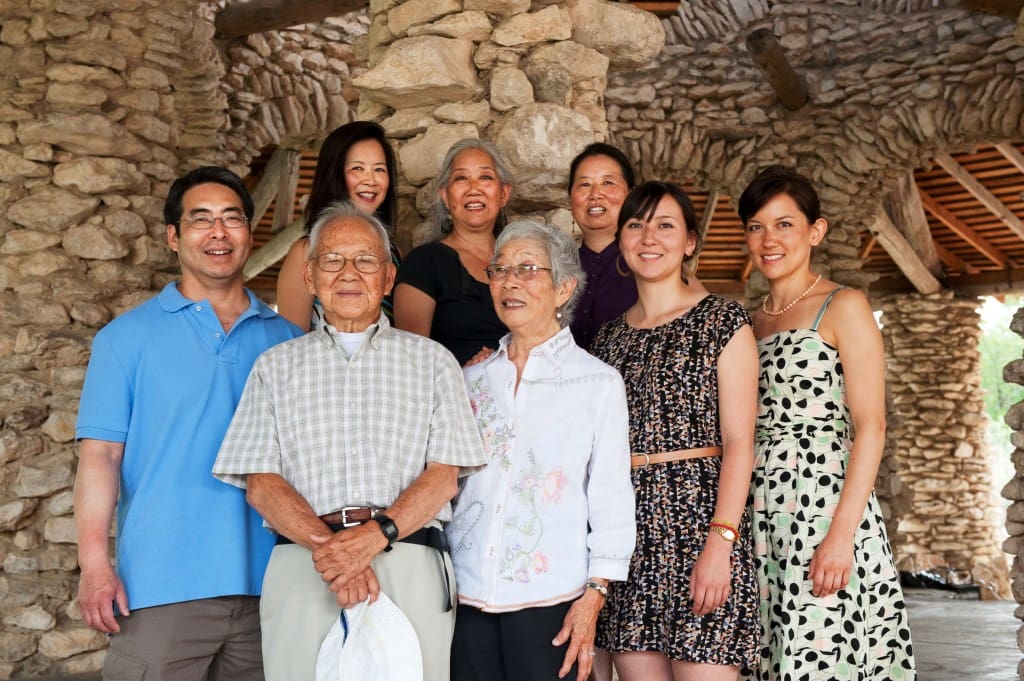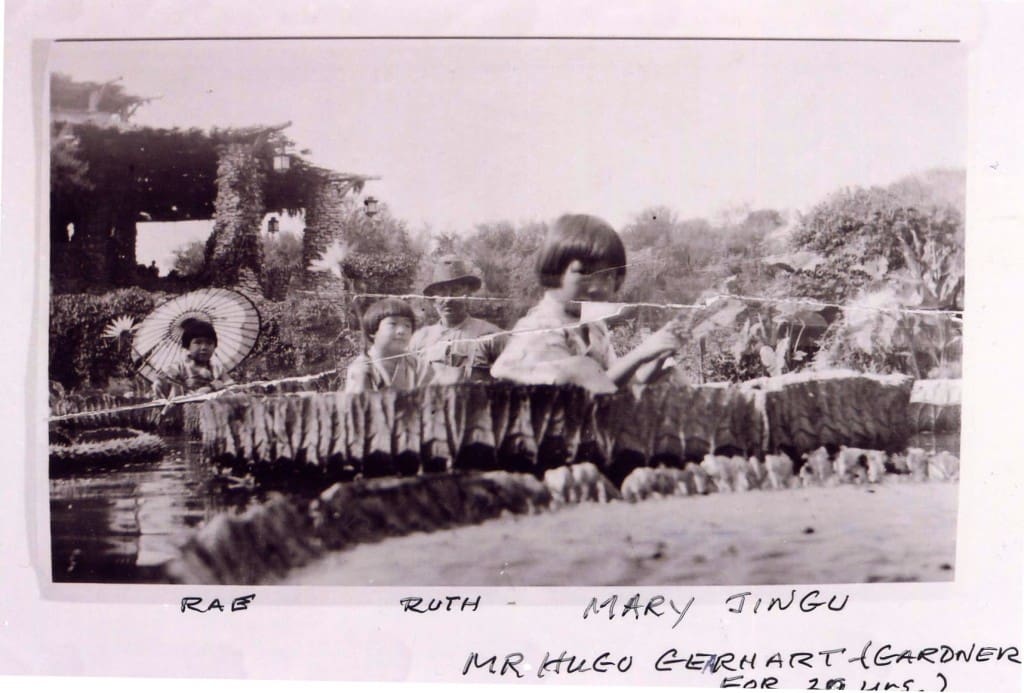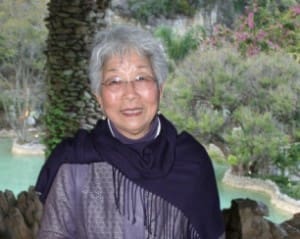World Japanese Garden Database
Japanese Gardens Around the WorldJapanese Tea Garden at Sunken Gardens
Origins – The “Hole” Story.

Japanese Tea Gardens, San Antonio Texas 1919
Like other gardens created from abandoned quarries, the Sunken Gardens in San Antonio’s Brackenridge Park is a diamond created from stone. In this case, the quarry was located in the middle of San Antonio not too far from the headwaters of the San Antonio River. This large cavity happened to be located right next to land donated to the city for a major park. When the park was opened to the public in 1901 and the quarry was abandoned in 1908, this presented a challenge.
A New Era
In 1915, Ray Lambert was appointed as San Antonio’s Parks Commissioner and turned his focus to Brackenridge Park development. He saw the challenge as opportunity with the vision of turning the quarry site into a “sunken gardens” with a zoo, an outdoor theater, and garden with large lily ponds as the centerpiece. In 1917, Park Engineer W. S. Delery created plans that included the lily ponds with a large central island and arched stone bridges connecting the island on two sides.
“Soon after the start of the project, J. R. Lambert, Park Commissioner, took the former owners of the cement company and a group of other prominent citizens, who had long known the rugged cliffs and the old cavities, on a motor ride along this driveway, and pointed out to them what was being done and the possibilities which might be realized if sufficient funds were available. Their cooperation was speedily enlisted, and the funds were forthcoming.“ W. S. Delery, Park Engineer |
In July of next year, construction began. Lambert’s Parks Department budget was not enough to see this project through. After winning the support of the group mentioned above, and with the help of prison labor and City employees, by May of 1919 the stone bridges, island, ponds and a large thatched pavilion were completed. The stone for the walls and bridges came mostly from the quarry. Exotic plants came from the city nurseries. The lily bulbs were donated by the Public Service Company.
Although not in the original plan, the public demand for lighting in the ponds and the garden was strong. The Public Service Company again helped by donating the lighting system. Using “invisible wires” strung from insulators on the cliff walls and across the pond, the pools were lit! Some of the insulators can still be seen today. Lights on the island and bridges were set in stone columns with the globes concealed.
When he was finished, Lambert had spent $7000 dollars. City prisoners were taught how to do the sometimes delicate work. City engineers built the bridges in between their regular duties. Not one person was hired outside the City system.
The Jingu family
In 1919, Ray Lambert invited local Japanese-American artist Eizo Jingu and his family to live in a house in the gardens (he adopted the name Kimi Jingu to make it easier to pronounce his name). Jingu became a representative for the Japan Tea Association (Shizuoka Tea Association) and in 1926, he opened the “Bamboo Room” and served light food and tea. The gardens became known as the “Japanese Tea Gardens”. The Jingu girls dressed in traditional kimonos and served the food and drink. San Antonio’s warm climate may have been Jingu’s inspiration for the creation of “iced green tea” and “green tea ice cream” that were served here!
“This (powdered green) tea had a very bitter taste and not something he could serve to the people coming to the tearoom, so he developed a cold iced green tea with a tablespoon of sugar and filled the glass with ice and a slice of lemon. Then an ice cream was created with the powdered green tea and the local Borden’s ice cream company made this ice cream to be served.“ Mabel Jingu, 2007 |

Jingu Family at the Tea Gardens
The Jingu’s continued to live in the garden, operating the tea room and developing the garden. Their two daughters, Mary and Ruth were soon joined by the first to be born in the garden, baby sister Rae (named after Commissioner Ray). Then came Helen, Mabel, Lillian, James and Kimi junior.
Mabel tells of the gardener, Mr. Hugo Gerhardt, who tended the garden and the pond in his “huge rubber boots”. Mr Hugo lived in one of the small houses down from the garden. Kimi junior liked to follow Mr. Hugo around and watch him work. Hugo Gerhardt was the gardener for 25 years.

Mr. Hugo with Rae, Ruth and Mary on Giant Amazon leaf!
Mabel also describes her father’s design for the tea room. The walls were covered with split bamboo. The ceiling featured four watercolors of the seasons he had painted. These were also framed in bamboo. All of the bamboo was harvested, split and burnished by Jingu. Here, and under the large pavilion, they served tea to San Antonians and tourists that came to the garden, and began selling the tea in beautiful lacquered canisters. One of the popular teas was “matcha”, the powdered green tea used in tea ceremonies.
Commissioner Lambert continued to develop the area. One inspiration came from the time Alamo Cement Company was mining the site. A small village of mostly Mexican American families that worked the cement plant set up shops selling traditional Mexican foods, arts and crafts. This became a popular site for tourists. When the company moved to a new site, the village died. Based on this concept, Commissioner Lambert constructed a new “Mexican Village” in 1920, down hill from the gardens near the site of the original village and revived the popular market.
Kimi Eizo Jingu dies of a heart attack in 1938, leaving Miyoshi and the children to run the gardens. When World War II brought anti-Japanese sentiment, it wasn’t long before Miyoshi and the children were asked to leave the gardens. With short notice, a widow with 7 children had no where to go. She was a member of Travis Park Methodist Church, and received help in locating a suitable rental house near the children’s schools, but they had to leave most of their furnishing behind, including her husbands art.
“My sister, Helen had the radio on December 7,1941 when we heard the announcer say that Japan had bombed Pearl Harbor in Honolulu, Hawaii. Being of Japanese ancestry and living in the public in Brackenridge Park was difficult for our family. Soon after the news came on the radio and in the papers, the city took action to evict us out of the house we lived in.” Mabel Jingu, 2007 |
The gardens were renamed “Chinese Tea Gardens” and a Chinese-American family, Ted and Ester Wu opened a snack bar there. In 1942, a sculpture called the “Chinese Tori Gate” was constructed by the renowned faux-wood artist Dionicio Rodriguez at the entry to the gardens. But in 1984, the gardens were officially renamed “Japanese Tea Gardens”. The sculpture remains as a significant historical artifact.
Restoration
A move to restore the Japanese Tea Garden came in the 2005 bond election to repair the Pavilion. With help and guidance from San Antonio Parks Foundation and Friends of the Parks, this Phase 1 began. The original roofing was fencing wire with palm leaf thatch, harvested from the city parks, woven together to shed water. The new roof is a fantastic mimic of artificial palm thatch – all the looks without the fire hazard.

Mabel Jingu Enkoji at the reopening
In 2007, former councilwoman Bonnie Conner, Parks Foundation vice chair of projects, and former Mayor Lila Cockrell, Parks Foundation president, began a $1.6 million restoration campaign to repair the lily ponds. The successful effort resulted in the restoration of the ponds, a new recirculating filtration system, and the return of fish and lilies to the ponds. For the public re-opening on March 8, 2008, Jingu and Lambert family members were present. Mabel Yoshiko Jingu Enkoji, the sixth child of Kimi and Miyoshi Jingu, and born at the Gardens, was the senior Jingu family member at the event. Richard Lambert, grandson of Commissioner Ray Lambert was also present.
A master plan is being created and fundraising will begin soon to continue the effort to return the Japanese Tea Gardens to its former glory as a jewel in the crown of San Antonio and South Texas.
Mabel Jingu Enkoji passed away Tuesday, July 15, 2013 at her home in California. The Mabel Jingu Enkoji Fund has been established to support the Tea Garden. Donations can be made here.
See also http://www.japaneseteagardensa.org/
Timeline:1840: German masons quarry limestone blocks for for the construction industry. 1852: The City begins leasing the quarry site for commercial use. 1880: Alamo Roman and Portland Cement Company constructs the first cement plant west of the Mississippi River. 1889: The tall stack Schoefer-type kiln was built. It is a landmark in the gardens today. 1899: George Washington Brackenridge donates 199 acres along the San Antonio River near the quarry to the City for use as parkland. He will continue to donate land to the park. 1901: Brackenridge Park opens to the public. 1908: Alamo Cement abandons the quarry site on Rock Quarry Road (now Saint Mary’s Street). 1915: Ray Lambert is appointed as City Parks Commissioner and begins to further the development of Brackenridge Park 1917: Under the direction of Ray Lambert, Park Engineer W. S. Delery develops plans for a “sunken garden”. 1918: Construction begins with the assistance of City staff and prison labor. 1919: Construction of bridges, island, ponds and pavilion is completed. Landscape is installed. 1919: Lambert invites Japanese-American Kimi Eizo Jingu and his family to live in a house in the gardens. Jingu was an artist specializing in Japanese style painting. Rae Jingu, the first of their children to be born in the gardens arrives in August. She is named after Commissioner Ray Lambert. 1920: A small “Mexican Village” was reconstructed featuring Mexican artisans and craftsmen as well as an outdoor restaurant. 1925: Daughter Mabel Jingu is born in the gardens. 1926: Jingu opens the “Bamboo Room”, serving light food and tea. Iced green tea and green tea ice cream are born. He becomes a representative of Shizuoka Tea Association. 1938: Kimi Eizo Jingu dies, leaving his wife and seven children to live and operate the gardens. 1941: Jungu family evicted due to anti-Japanese sentiment of World War II. The gardens are renamed “Chinese Tea Gardens” and Chinese-Americans Ted and Ester Wu open a snack bar. 1942: A sculpture called the “Chinese Tori Gate” was constructed by artist Dionicio Rodriguez at the entry to the gardens. 1943: Jimmy Jingu enlists in the US Army. He receives injuries in Italy for which he received the Purple Heart. 1976: Added to the National Register of Historic Places ( listed as Alamo Portland and Roman Cement Works). 1984: The gardens are officially renamed as the “Japanese Tea Gardens” 1984: The gardens are named as a Texas Civil Engineering Landmark and Registered Texas Historic Landmark. 2006: The Pavilion is renovated with the assistance of bond monies and San Antonio Parks Foundation. 2008: The lily ponds are improved and sealed. The ponds are filled and the fish and plants are restored. A plan to renovate the Jingu home is completed. 2009: Funds are raised and restoration begins on the Jingu house. Completion is expected for the Spring of 2011. 2011: The remodeled Jingu House will have its public opening on October 22, 2011.
|
Garden Search
Adachi Museum of Art Garden 足立美術館
320 Furukawacho, Yasugi, Shimane 692-0064, Japan +81 0854-28-7111...
Admiral Nimitz Museum Japanese Garden of Peace
340 E Main StFredericksburg, TX 78624 (830)...
Albert Kahn Japanese Garden
10-14 rue du Port 92100 Boulogne-Billancourt, France +33 (0)1 55 19 28...
Anderson Gardens
318 Spring Creek Rd Rockford, IL 61107 +1 815 229 9390...
Asticou Azalea Garden
3 Sound DriveNortheast Harbor, ME 04662 (207)...
Auburn Botanic Gardens Japanese Garden
Chiswick Rd & Chisholm RoadAuburn NSW 2144, Australia +61 2 9735...
Barron County Japanese Garden at Rice Lake, WI.
S Wisconsin AveRice Lake, WI 54868 University Phone:...
Birmingham Botanical Garden
2612 Lane Park RdBirmingham, AL 35223 (205) 414-3950...
Bloedel Reserve Japanese Garden
7571 NE Dolphin Dr Bainbridge Island, WA 98110 206-842-7631...
Botanical Gardens of Rome – Japanese Garden
Largo Cristina di Svezia 23 A - 24 00165 Roma RM,Italy +39 06 49917107...
Byodo-in 平等院
116 Uji Kyoto 611-0021, Japan 0774-21-2861 www.byodoin.or.jp/enFollow...
Charlotte Partridge Ordway Japanese Garden (Como Park)
1225 Estabrook DrSt Paul, MN 55103 +1 651...
Chion-in in Higashiyama 知恩院
400 Rinkacho, Higashiyama Ward Kyoto, Japan +81 075-531-2111...
Daisen-En 大仙院
〒603-8231 54-1 Murasakino DaitokujichoKita-ku, Kyoto 603-8231 +81...
Daitoku-ji 大徳寺
53 Murasakino Daitokujicho,Kita Ward, Kyoto, Japan603-8231 +81...
De Japanske Haver – Denmark
Vøjstrupvej 43 5672 Broby, Denmark +45 6363 0015...
Denver Botanic Gardens Sho-fu-en
1007 York Street Denver, CO 80206 720-865-3500...
Descanso Gardens
1418 Descanso Dr La Cañada Flintridge, CA 91011 (619) 232-2721...
Dooleys’ Japanese Garden at Maymont
1700 Hampton Street Richmond, Virginia 23220 804-525-9000...
Earl Burns Miller Japanese Garden
Earl Warren Dr Long Beach, CA 90840 (562) 985-8420...
Elizabeth Hubert Malott Japanese Garden (Sansho-En)
1000 Lake Cook RoadGlencoe, IL 60022 +1 (847)...
Embassy of Japan in Australia 在オーストラリア日本国大使館
112 Empire Cct, Yarralumla ACT 2600, Australia +61 2 6273 3244...
Fabyan Estate Japanese Garden
1925 S Batavia Ave, Geneva, IL 60134 (630) 377-6424...
Fort Worth Japanese Garden – Japanese Garden
3220 Botanic Garden Blvd Fort Worth, TX 76107 (817) 332-4441...
Gan Ryuu Tei – Cleveland Botanical Garden
11030 East Blvd, Cleveland, OH (216) 721-1600...
Ganna Walska Lotusland
Cold Spring Rd, Montecito, CA 93108 (805) 969-9990...
Ginkaku-ji 銀閣寺
2 Ginkakujicho, Sakyo Ward, Kyoto, 606-8402, Japan +81 75-771-5725...
Gosford/Edogawa Commemorative Garden
36 Webb St, East Gosford NSW 2250, Australia +61 02 4325-0056...
Grand Hyatt Atlanta in Buckhead
3300 Peachtree Rd NE Atlanta, GA 30305 +1 404 237 1234...
Gyokudō Art Museum (Gyokudō Bijutsukan 玉堂美術館)
1 Chome-75 Mitake Ome, Tokyo Japan +81 0428-78-8335 www.gyokudo.jp...
Hakone Estate & Gardens
21000 Big Basin Wy Saratoga, CA 95070 +1 (408) 741-4994...
Hama-rikyū-onshi-teien (浜離宮恩賜庭園)
1-1 Hamarikyūteien Chuo City, Tokyo 104-0046 Japan +81 03-3541-0200...
Heian Jingu 平安神宮
2215 Pan American E Rd, San Diego, CA 92101 +81 (619) 232-2721...
Hermann Park Japanese Garden
6000 Fannin St Houston, TX 77030 713-524-5876 hermannpark.orgFollow...
Hobart Japanese Garden, Tasmania
Lower Domain Road Queens Domain, Hobart Tasmania +61 03 6166 0451...
Holland Park’s Fukushima Garden – London
London W8 7QU United Kingdom +44 020 7602 2226...
Holland Park’s Kyoto Garden – London
Holland Park, Holland Park Ave, London W11 4UA, United Kingdom +44 020...
Huntington Library & Botanical Gardens
1151 Oxford Rd San Marino, CA 91108 +1 626 405-2100...
Imahara Botanical Garden
5341 225, St Francisville, Louisiana (225) 635-6617...
James Irvine Japanese Garden
244 San Pedro St, Los Angeles, CA 90012 (213) 628-2725...
Japanese Community Garden at Salt Palace Convention Center
90 S W TempleSalt Lake City, UT 84101 (385)...
Japanese Friendship Garden & Museum
2215 Pan American E Rd, San Diego, CA 92101 (619) 232-2721...
Japanese Garden at Atlanta Botanical Garden
1345 Piedmont Avenue Atlanta, GA 30309 404-876-5859...
Japanese Garden at Brisbane Botanic Gardens
Mount Coot-Tha Rd Toowong QLD 4066 Australia +61 7 3403 2535...
Japanese Garden at Gibbs Garden
1987 Gibbs DrBall Ground, GA 30107 70 893-1881gibbsgardens.comFollow...
Japanese Garden at Kidd Springs Park
Garden Description This Japanese garden sits on the hillsides next to...
Japanese Garden Tamborine Mountain Botanical Garden
Use arrows to...
Japanese Gardens and Tea House Campbelltown
Description: The Campbelltown Japanese Gardens celebrate the...
Japanese Landscape at Kew Royal Botanic Garden
Description: The...
Jizō-In 地蔵院
Description: Jizō-in...
Jó Ryó En Japanese Garden at Carleton College
1 North College StNorthfield, Minnesota...
Ju Raku En Japanese Garden
Description: Regarded as Australia’s largest and most...
Kasugai Gardens
1435 Water St,Kelowna, BC V1Y 1J4,Canada +1 (250) 717-2757...
Kasugai Gardens now 2
Open early March to October 31, 9 am to 5 pmEntry or Parking...
Kinkaku-ji 金閣寺
...
Kiyomizu-dera 清水寺
Description:...
Kodai-ji 高台寺
Description: From the official website in English: Kodai-ji Temple is...
Koke-dera 苔寺 (or Saihōji 西芳寺)
Photos by Don...
Koko-En 好古園
Description: Koko-en was constructed in 1992 at the foot of Himeji...
Kōtō-in 高桐院
Photos by Don...
